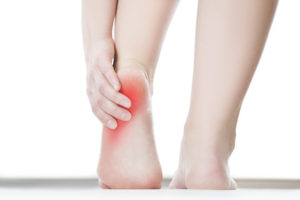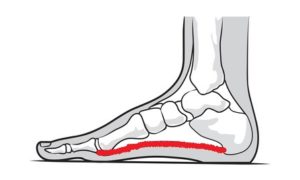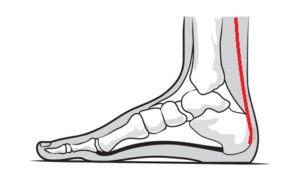Pain in the Heel – a common musculo-skeletal foot injury

Pain in the heel- a musculo skeletal injury of the foot
Heel pain is a fairly common foot problem caused primarily due to two main reasons – Plantar Fasciitis and Insertional Achilles tendonitis. Other causes include heel spurs, arthritis, stress fractures, nerve irritations and even cysts. Mysterious and almost life-threatening sounding aren’t they? Well, luckily it’s nothing quite that serious but pain in the heel can be intense, annoying, distracting and you will definitely want it to go away. Learn more about diagnosis, causes and treatment for Pain in the Heel.
Pain in the Heel caused by Plantar Fasciitis

Plantar fascia location
Unlike what the name suggests, plantar fasciitis has nothing to do with plants or fungi of any kind. The Plantar Fascia is a ligament-like tissue and extends from the heel to the toes along the bottom of your foot. It supports the arch and helps you walk. Plantar Fasciitis is an inflammation of section of the band of tissue. The result can be pain in one or more locations. One such location is the heel. The plantar fascia experiences a fair amount of wear and tear in daily life – every time we walk, run, jog or stand. The fascia acts as shock absorber and stabilizer. Unfortunately, too much pressure on the feet (especially in case of runners, athletes and mothers carting little munchkins around) can damage, inflame or even tear the fascia. So when the plantar fascia is inflamed or otherwise strained in any manner, it stiffness and potentially becomes more at risk of injury. Pain in the heel is one possible injury – categorized as a musculo-skeletal injury.
Symptoms of Plantar Fasciitis
- Sharp pain directly under the heel.
- Pain is common first thing in the morning or when you stand up after sitting for a long period.
- Pain usually eases when you walk around but comes back after rest.
- Usually decreases when sleeping and rarely causes interference in sleep.
- Pain persists and increases over a long period of time if not treated.
Pain in the Heel caused by Achilles Tendonitis

Foot showing Achilles tendon
Pain at the back and base of the heel can different to the condition described as Plantar Fasciitis. Back and base of the heel pain is more commonly associated with Achilles tendonitis. The Achilles Tendon starts in the lower one-third of the leg (it joins up with your calf muscle) and attaches into the bone of your heel ( the calcaneus). It is the main structure involved in movement at the ankle. Achilles Tendonitis , an inflammation of a section of the tendon, can occur at multiple locations including where the tendon attached to the bone of the heel – this is more correctly referred to as Insertional Achilles Tendonitis.. The Achilles Tendon plays its part in all of our daily lives, so when it is inflamed, strained or stiffened heel pain is another type of Pain in the Heel – another injury categorized as a musculo-skeletal injury. Just to make things really tricky, sometimes Plantar Fasciitis and Achilles Tendonitis occur at the same time.
Symptoms of Insertional Achilles Tendonitis
- Sharp or nagging pain directly under and at the back of the heel.
- Pain is common first thing in the morning or when you stand up after sitting for a long period.
- Pain usually eases when you walk around but comes back after rest.
- Usually decreases when sleeping and rarely causes interference in sleep.
- Pain persists and increases over a long period of time if not treated.
- Notice how these symptoms are similar to Plantar Fasciitis
Life Activities than can lead to Pain in the Heel
- Too much activity or advanced training too quickly. Long distance runners commonly face this problem as do athletes.
- Standing for prolonged periods on concrete or hard surfaces.
- Structural problems like flat feet, tight calves, very high arches.
- Gradual or sudden increase in weight adding to the pressure.
- Faulty footwear (yes, unfortunately high heels do come in this category especially if you have any kind of heel pain).
Self Management for Heel Pain
Here are some first line treatment strategies for heel pain that you can begin at home especially if the problem is in its beginning stages. Ignoring the pain, battling on or pretending it will go away because everything else in your life is more important is not a good idea.
- Stretch calf muscles with gentle stretching exercises. This helps to prevent them from getting inflamed and stretching reduces the pain. However, if you are suffering from significant heel pain, you may want to rest the foot for a while to reduce inflammation before beginning the stretches.
- Use comfortable and supportive footwear at all times – even within the home. Look for shoes with good arch support and a slightly raised heel to reduce heel pain.
- Ice your heel for 20 minutes daily to reduce inflammation. If you are engaging in vigorous activity, it is advisable to ice the heel before and after your routine to keep the heel pain manageable.
- Limit strenuous activity for some time to allow the heel to recover.
Medical Assistance for Heel Pain
If the heel pain is persistent and continues to increase despite your care, it may be a good idea to visit a podiatrist, that is, a health professional specializing in the foot and ankle. Common suggestions for heel pain made by podiatrists include:
- Padding the shoes so that it softens the impact of walking.
- Orthotic devices that fit into your shoes to allow for any structural deficits causing the plantar fasciitis like flat feet.
- In severe cases, the podiatrist may recommend corticosteroid injections to reduce the heel pain and the inflammation.
- Sometimes a removable cast or a night splint may be recommended to provide the foot the rest that it needs and to allow your muscles to stretch even while you sleep.
- Physical therapy is often recommended to provide relief from heel pain.
- Non invasive Shockwave Therapy or Low level Laser Therapy have gained traction and credibility over the last 15 years
- A tiny percentage of people may require heel surgery.
Although treatment can help relieve heel pain, since it is attributable to inflammation, the truth is that prevention in this case is better than cure. Wearing supportive shoes, doing regular stretches and using orthotic devices if need be is the best way to keep your heels pain free. Pain in the Heel – a sometimes tricky musculo-skeletal injury.


Recent Comments